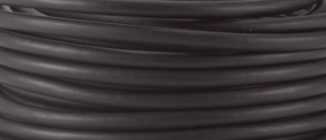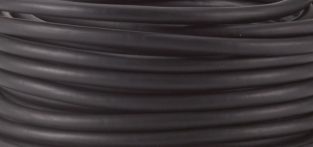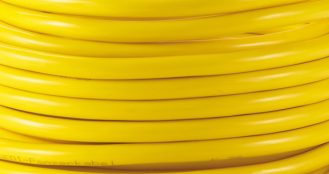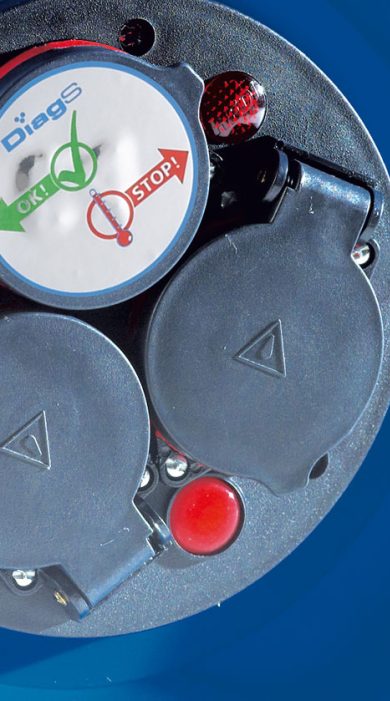HEDI FAQ: Häufig gestellte Fragen
Welches Kabel eignet sich für welchen Einsatz?
PVC cable (H05VV-F)

Für den ständigen Einsatz in trockener Umgebung. Bei dieser Leitung besteht sowohl die Isolierhülle, als auch der Mantel aus PVC-Kunststoff und ist nur in trockener Umgebung zugelassen. Die Nennspannung liegt bei 300 / 500 V.
Rubber cable (H05RR-F)

Für den vorübergehenden Einsatz im FeienBei dieser Leitung besteht sowohl die Isolierhülle, als auch der Mantel aus Naturkautschuk und ist in trockener Umgebung, sowie für den kurzfristigen Einsatz im Freien zugelassen. Die Nennspannung liegt bei 300 / 500 V.
Neoprene rubber cable (H07RN-F)

Für den ständigen Einsatz im Freien. Bei dieser Leitung besteht die Isolierhülle aus Naturkautschuk und der Mantel aus Neopren-Gummi. Sie ist für den ständigen Einsatz im Freien zugelassen, sowie öl- und säurebeständig. Die Nennspannung liegt bei 450 / 750 V. Diese Leitung bieten wir in zwei verschiedenen Farben an.

HEDI armoured cable (K35/At-N07V3V3-F)

Extrem robustes Kabel, für den ständigen Einsatz im Freien. Bei dieser Leitung besteht sowohl die Isolierhülle, als auch der Mantel aus kältebeständigem PVC-Kunststoff. Sie ist für den ständigen Einsatz im Freien zugelassen. Diese Leitung ist extrem robust gegen Abrieb und Quetschungen, vollkommen wetterfest, öl- und säurebeständig, mikrobenfest und versprödungssicher. Der zugelassene Temperaturbereich liegt bei -35°C und +80° C. Die Nennspannung liegt bei 450 / 750 V. Attention! Not approved for use on german construction sites.
HEDI amoured cable PLUS (H07BQ-F)

Bei dieser Leitung besteht die Isolierhülle aus Synthetik-Kautschuk und der Mantel aus Polyurethan. Sie ist für den ständigen Einsatz im Freien zugelassen. Diese Leitung ist extrem robust gegen Abrieb und Quetschungen, vollkommen wetterfest, öl- und säurebeständig, mikrobenfest, versprödungssicher und hält hoher mechanischer Belastung stand. Der zugelassene Temperaturbereich liegt bei -40°C und +90° C. Die
Nennspannung liegt bei 450 / 750 V. Diese Leitung bieten wir in vier verschiedenen Farben und mit personalisiertem Kabeldruck an.

What material is a cable reel made of?
Kunststoff oder Stahlblech - das hängt von dem jeweiligen Einsatzzweck ab. Die Berufsgenossenschaft (DGUV-I 203-006) schreibt vor, dass auf deutschen Baustellen ausschließlich Kunststoff-Kabeltrommeln verwendet werden dürfen. Die Empfehlung von HEDI ist eine (Voll-)Kunststoff-Kabeltrommel, da diese leicht und aus einem schlagfesten Kunststoff gefertigt ist. Bei der Verwendung der Kunststofftrommel im Innenbereich ergibt sich der Vorteil, dass empfindliche Böden vor Verkratzungen geschützt werden können.
What is the cross-section of a cable?
The cross-section of the cable e.g. 25 m H07RN-F 3G1,5 beschreibt die Querschnittsfläche des Leiters. Und die Fläche ist für die relevanten elektrischen Eigenschaften des Leiters verantwortlich. Der benötigte Querschnitt der Leitung hängt von einigen Faktoren ab: Der maximalen Strombelastbarkeit des Leiters, der Länge des Kabels und dem maximal zulässigen Spannungsabfall. Leiter mit hohem Querschnitt dürfen mit höheren Strömen belastet werden als Leiter mit geringerem Querschnitt.
How much can I load a cable reel?
with coiled cable
with a completely unwound line
AC cable reel
230V ~ 50Hz 16A
1100 Watt
3500 Watt
Three-phase cable reel
400V ~ 50Hz 16A
3000 Watt
9500 Watt
Three-phase cable reel
400V ~ 50Hz 32A
6100 Watt
19500 Watt
How many metres of cable fit on a cable drum?
Enscheidend für die Auswahl einer Kabeltrommel ist die Kabellänge. Je größer der Durchmesser des Trommelkörpers, desto höhere Kabellängen und größere Querschnitte kann die Trommel potentiell tragen. Bitte beachten Sie, dass mit steigender Kabellänge und höherem Querschnitt, auch das Gewicht der Trommel deutlich zunimmt. Beim Einsatz im Inneren müssen Sie meist weniger Strecke überbrücken, hierfür sind geringere Leitungslängen (z.B. 25 m) häufig ausreichend. Bei Einsätzen im Außenbereich und auf Bau- und Montagestellen sind die Strecken meist deutlich weitläufiger. Als Standardmaß empfiehlt HEDI hier eine Trommel mit 40 Metern Leitungslänge. Dieses Maß ist praktikabel und deckt die meisten Einsätze ab.
Why do I need a cable drum with coloured cable?
The standard colour of a cable is black. Nevertheless, when buying a cable drum, you should consider whether it would not be better to have a coloured cable. The coloured cable is much more visible when it is unrolled on the floor. This helps to avoid accidents. We also offer the cable colours red (for neoprene-rubber cables H07RN-F) or orange, yellow, green, blue (for armoured cable PLUS H07BQ-F).
What does the IP class say about a cable drum?
Für die jeweiligen Anwendungsbereiche ist der IP-Code („International Protection Code“) sehr wichtig. Darüber lässt sich herausfinden, für welche Einsatzbedingungen die Kabeltrommel geeignet ist.
What safety features does a cable drum have?
The highest level of safety is HEDI's claim. For outdoor use, the cable drum should always have a closed socket insert. A thermal protection switch for the cable drum is also an absolute standard. In addition, some HEDI cable reels have the unique HEDI diagnosis system DiagS, which shows at a glance whether the cable reel is ready for use and whether the operating voltage is present at the sockets.
Are there cable drums with foreign plug-in systems?
Das HEDI Standardsortiment beinhaltet selbstverständlich Kabeltrommeln mit allen gängigen Auslandsstecksystemen. Hierunter zählt das schweizer, britische und französische bzw. belgische Stecksystem. Im deutschsprachigen Raum ist auch das schweizer Stecksystem, verbreitet. Dieses bieten wir mit 4-fach Steckdoseneinsatz (IP20) oder 3-fach Steckdoseneinsatz (IP55) an.
Why should you always unroll a cable reel completely?
Die Leitung wird warm, wenn Strom durch fließt. Wenn die Leitung nicht abgerollt wird, summiert sich diese Erwärmung der einzelnen
Kabelwicklungen auf, was bei Überlast zum Schmelzen des Mantels und zur Zerstörung der Kabeltrommel führen kann.
What is a cable reel with slip ring?
Der Schleifring (SR) ermöglicht es Ihnen Geräte an der HEDI Kabeltrommel angeschlossen zu lassen, während Sie die Trommel abwickeln. Dank einer speziellen Konstruktion dreht sich der Steckdoseneinsatz nicht mit. Diese Option ist vor allem bei einer Gerätekabeltrommel praktisch und sinnvoll. Bei allen anderen Kabeltrommeln empfehlen wir den Schleifring, wenn Sie Arbeitsgeräte flexibel einsetzen wollen oder wenn Sie sich viel mit Ihren Arbeitsgeräten bewegen. Besonders praktisch ist der Schleifring beim Einsatz auf Gerüsten oder Montagewägen und sorgt für Bewegungsfreiheit trotz eingesteckter Geräte. Vorteile: Bequem Ihre Geräte anschließen, abrollen und loslegen - die Ausführungen mit Schleifring machen es möglich. Kein Verknoten der Leitungen. Verfügbar bei allen Gerätekabeltrommeln und Wechselstromausführungen des Generation 7 Champion.

Warum löst der Thermoschutzschalter einer Kabeltrommel aus?
- The thermal circuit breaker is a protective device that must interrupt the circuit in the event of overheating so that there is no danger of excessive heating.
- The temperature limit values are prescribed by standards.
- When rolled up, the cable drum heats up faster, even if only a few meters are still rolled up on the drum (please note the information on the type plate).
- If machines with high power consumption are used without starting current limitation, the thermal protection switch must switch off when the permissible limit values are exceeded.
- When the drum is heated, two factors work together. On the one hand, it is the temperature of the reel itself that heats up through use, and on the other hand, it is the ambient temperature. These two temperatures add up.
Example: The thermal circuit breaker trips more quickly in cable reel operation at high ambient temperatures, even if the maximum load limit has not yet been reached. On the other hand, if the ambient temperature is low, it will only trigger later, even under high loads.
Warning:
Bridging the thermal circuit breaker can lead to serious defects in the cable reel and to fire. In the case of changes of this kind, any liability on the part of the manufacturer expires and the person responsible is responsible for any resulting damage.
Application note:
Bei Überhitzung der Kabeltrommel diese ganz abrollen und abkühlen lassen. Danach den roten Thermoschutzknopf im Steckdoseneinsatz tief eindrücken.
SUMMARY:
Das Auslösen des Thermoschutzschalters und damit die Abschaltung der Kabeltrommel ist eine vorgeschriebene Funktion und dient der eigenen Sicherheit des Benutzers. Bei hoher Umgebungstemperatur oder bei Einsatz von großen Maschinen ohne Anlaufstrombegrenzung ist das Auslösen des Thermoschutzschalters vorgeschrieben und normal. Dies ist kein Defekt!
You have further questions concerning the thermal protection swift?
Warum ist der Schutzleiter-Widerstand bei Prüfungen nach DGUV Vorschrift 3 (ehem. BGV A3) zu hoch?
Üblicherweise ist bei Prüfgeräten ein Widerstandsgrenzwert für Schutzleiter von 0,3 Ω voreingestellt. Dies ist auch richtig, zumindest für die meisten prüfpflichtigen Geräte, welche kurze Anschlussleitungen bis maximal 5 Meter haben. Bei Verlängerungsleitungen oder Kabeltrommeln ist die Leitung oft länger. Deshalb muss der Widerstandsgrenzwert wie in der Norm DIN VDE 0701-702 unter Punkt 5.3 beschrieben dementsprechend angepasst werden.
DIN EN 50678 / 50699 Punkt 5.3
Bei Kabellängen von bis zu 5 m und einem Querschnitt bis 1,5 mm² darf der Schutzleiterwiderstand 0,3 Ω nicht überschreiten. Für weitere 7,5 m Kabellänge wird der Grenzwert um 0,1 Ω bis zu einem Höchstwert von 1 Ω addiert.
DIN VDE 0701-702 Punkt 5.3
For cables up to 5 m in length and up to a rated current of 16 A, proof must be provided that the resistance of the protective conductor does not exceed the limit value 0.3 Ω. For longer cables up to a rated current of 16 A, the limit value may be increased by 0.1 Ω for every 7.5 m additional length up to a maximum value of 1 Ω.
Ein Beispiel mit einer 50 Meter Kabeltrommel: Die ersten 5 Meter ≙ 0,3 Ω die restlichen 45 Meter geteilt durch 7,5 = 6 (≙ 0,6 Ω) Somit gilt für eine Kabeltrommel mit 50 Metern Leitung ein Grenzwert von 0,9 Ω Anstatt von 0,3 Ω
What are the requirements of DGUV Information 203-006 (previously BGI / GUV-I 608)?
DGUV-I 204-006 regulates the selection and operation of electrical systems and equipment on construction and assembly sites.
- Only cables, cable reels and socket distributors with splash-proof sockets (protection class IP44 or higher) are permitted.
- Use of H07RN-F and H07BQ-F cables.
- In the case of cable reels, both the handle, the twist grip and the drum body must be made of an insulating material or be encased in one.
For more information, please refer to the current version of DGUV-I 203-006, which you can download on the Internet from the employer's liability insurance association.
What do the new energy efficiency classes and energy efficiency labels say from September 2021?
Die modernen Lichtquellen werden immer effizienter in ihrem Energieverbrauch. Der Gesetzgeber hat aus diesem Grund die Effizienzklassen neu definiert. Anstatt die Klasse A um weitere Pluspunkte zu erweitern, werden die neuen Energieeffizienz-Labels Produkt für Produkt auf eine einfache Skala von A bis G umgestellt. Die höheren Kategorien bleiben zunächst leer, um Innovationen zu fördern und Raum für Fortschritte zu lassen. Bei dem neuen Etikett wird die Energieeffizienzklasse einer Lichtquelle anhand neuer, höherer Standards bestimmt.
Eine weitere Neuheit auf den Energieeffizienz-Labels ist der QR-Code, der ab dem 1. September 2021 direkt zu den Informationen über das Produkt in der europäischen Produktdatenbank EPREL führt.
Warum ist kein Energieeffizienzlabel für Leuchten mehr erforderlich?
Gemäß der EU-Verordnung 2019/2015 ist nur noch die Angabe der Energieeffizienzklasse der Lichtquelle erforderlich. Somit entfällt die bisherige Regelung, dass auf den Verpackungen der Leuchten ein Energieeffizienzlabel angebracht sein muss. Auf den Verpackungen der Lichtquellen hingegen muss das Energieeffizienz-Label angebracht sein.
What is the beam angle of a machine light?
Bei der Entscheidung, welche Leuchte die richtige für Ihren Einsatz ist, ist die zu beleuchtende Fläche ein wichtiger Aspekt. Der Abstrahlwinkel gibt Auskunft darüber, in welchem Winkel Licht durch eine Leuchte nach vorne ausgestrahlt wird. Der Abstand der Leuchte zu dem beleuchtenden Objekt ist ebenfalls ein grundlegender Faktor. Für eine gleichmäßige Ausleuchtung großer Flächen sollten breit strahlende Leuchten mit großem Abstrahlwinkel eingesetzt werden. Der Halbwertswinkel definiert den Winkel, in dem ein Spot mindestens mit der Hälfte seiner maximalen Lichtstärke strahlt.
Was ist die Beleuchtungsstärke (Lux) einer Leuchte?
Die Beleuchtungsstärke definiert, wie viel Licht auf einen Punkt einer Fläche fällt. Da die Beleuchtungsstärke abhängig von Raummerkmalen und Auswirkungen weiterer Lichtquellen, wie z.B. dem Tageslicht ist, sollte man sich bei einer Entscheidung eher auf den Lichtstrom und den Abstrahlwinkel fokussieren. Die Norm zur Ermittlung der Lichtstärke gibt vor, eine Leuchte bzw. eine Lichtquelle in einem komplett abgedunkelten Raum zu prüfen, um deren Werte zu messen.
What does the colour temperature (Kelvin) of a machine luminaire mean?
Die Lichtfarbe beschreibt das farbliche Aussehen des Lichts einer Lichtquelle und wird durch die Farbtemperatur in Kelvin (K) beschrieben. Sie ist ein entscheidendes Kriterium für die Wahl einer Leuchte. Der Kelvin-Wert einer Lichtquelle gibt Aufschluss darüber, ob sie ein kühl oder warm wirkendes Licht abgibt. Je niedriger der Kelvin-Wert, desto mehr tendiert das Licht zu „Warmweiß“. Ist der Wert höher, wirkt das Licht kühler („Kaltweiß“). An Arbeitsplätzen eignen sich am besten Leuchten, welche konzentrationsfördernd sind und einem „Tageslicht-Weiß“ bzw. „Neutral-Weiß“ ähneln. HEDI bezeichnet diese Farbtemperatur mit 6.500 Kelvin als „WorkWhite“.
What is the colour rendering index (CRI) of a machine luminaire?
Die Farbwiedergabe einer Lichtquelle kennzeichnet die farbliche Wirkung, die ihr Licht auf Objekte verursacht. Der Farbwiedergabeindex (Ra oder CRI) gibt an, wie natürlich Farben im Licht einer Lichtquelle wiedergegeben werden. Bei z.B. Malertätigkeiten spielt dieses eine wichtige Rolle. Ein hoher Farbwiedergabeindex von mindestens 80 sollte hierfür verwendet werden. Die Skala reicht bis 100.
What is the luminous efficacy (lumen / W) of a machine luminaire?
The ratio between lumens (luminous flux) and watts (power consumption) is called luminous effi cacy and best describes energy efficiency. The higher the lumen/watt ratio, the better a light source converts the electrical energy introduced into light.
What is the luminous flux (lumen) of a machine luminaire?
Der Lichtstrom wird in Lumen (lm) gemessen und berschreibt die Lichtleistung einer Lichtquelle unabhängig vom Abstrahlwinkel. Dadurch kann man Rückschlüsse auf die Helligkeit einer Leuchte ziehen. Je höher der Lumen-Wert ist, desto mehr Licht gibt eine Leuchte (pro Zeiteinheit) ab. Zur Zeit der Glühbirne und Leuchtstofflampen war die Einheit Watt als Entscheidungskriterium ausreichend um ein Fazit über die Helligkeit ziehen zu können. Seinerzeit galt: Je mehr Watt, desto heller die Leuchte. Das gilt heutzutage nicht mehr.


Discover products and offers
You can find our catalogue and all current product flyers and offers in our online catalogue portal.
Interested in our products? Contact us. We will submit you to one of our trading partners located beneath you or advise you on our products.
Contact us
When you contact us, you consent to the processing of the transmitted data for the purpose of handling your request. The consent is voluntary. You can revoke your consent at any time by sending us an informal declaration, without this affecting the lawfulness of the processing carried out on the basis of the consent until revocation. Should the consent be invalid, the data processing will be carried out on the basis of Art. 6 Para. l lit. f DS-GVO for the purpose of processing your request. For further information, please refer to the data protection declaration. uns without affecting the lawfulness of the processing that took place until the revocation. Should the consent be invalid, the data processing will be carried out on the basis of Art. 6 para. l lit. f DS-GVO for the purpose of processing your request. For further information, please refer to the Terms of privacy.
*MANDATORY FIELD
Adress:
HEDI GmbH
Elektro- und Gerätebau
Schöneggweg 17
D-87727 Babenhausen
Phone:
Fax:
+49 (0) 8333 92 11 -75
E-Mail address:

